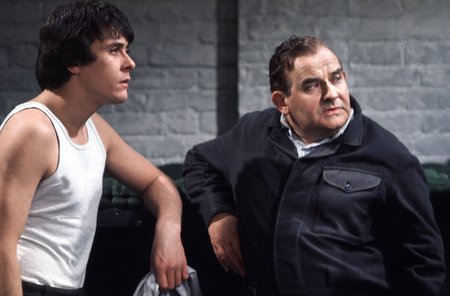
Damon Grant was the first heart throb in the now defunct British soap opera Brookside and was played by Simon O'Brien. The character was part of the initial cast,appearing from episode one in 1982 until 1987. At the time of the soap'sinception, Damon was the youngest son of Bobby and SheilasGrant, with an older brother, Barry and older sister, Karen.
Damon was introduced after having broken into the Collins' house in the first episode on 2 November 1982, aged 14. When ques tioned about the theft of a lavatory and vandalism that occurs by Paul Collins, Bobby lashes out at Damon. Barry defends Damon after the occurrence, pointing out that he did not have the tools to remove the lavatory in the way it had been done and that the graffiti could not have been Damon either as "he only spells 'bollocks' with one 'l'".

The Brookside soap opera wasregarded as tackling social issues, andthis was no less true when dealing with the Grant family, and Damon. One of the first of the show's manyteenage characters to capture the viewing public's imagination, the role saw O'Brien catapulted tofame as a teen heart throb, andhis adoption of the "mullet" hairstyle proved to be in keeping withthe zeitgeist of the times,and saw the character further entrenched as a cultural reference point.
Storylines saw Grant presented initially as a cheeky, lovablecharacter, with a close group of friends. The manner of Grant'scharacterisation, both by the writers, directors and by O'Brien, led Jane Root, writing in Open the Box: About Television,to cite the character as evidence of "complex male characters andmasculine storylines". Root saw this focus as different from establishedsoap operas.

As the character grew olderand left school, the writers used storylines to comment on life in Thatcher's Britain. Unemployment was a serioussocial issue, especially in a dock citysuch as Liverpool, andGrant's character struggled to find work. Eventually he took a position as a painter & decorator throughthe recently introduced YTS scheme,the writers depicting the excitement and later despair when Grant'sparticipation failed to lead to a full-time job to great effect.
The character was then shown todevelop a relationship with DebbieMcGrath, played by GillianKearney. McGrath was an underage school girl, and the relationshipcaught the heart of viewers. WhenO'Brien decided to leave the show, the producers of Brookside decided to spinthis plotline into a separate show, Damon& Debbie, broadcast in a later timeslot than that in which Brooksidewas shown.
This three part series, credited as the first 'soap bubble'. moves the character out from Liverpoolin search of work. In the first episode the couple squat on a boat on theRiverOuse in York, in the second episode they moveto Morecambe and then Bradford, where Damon gets a job as agroundsman at Valley (thestadium of Bradford City footballclub) before they finally return to York in the third episode. Ultimately, thecharacter is stabbed by Crosby actor Jonathan Comer, and dies at the end of theseries at O'Brien's request, amove which sparked upset and outrage amongst fans of the show, and added toboth Brookside's fame and notoriety.

Within the Brookside show thecharacter's death was used as a catalyst for again exploring a number ofissues, including the grief of the character's mother, played by Sue Johnston, and that of the character's father, Bobby Grant, played by RickyTomlinson, who was shown as blaming the death upon his unemployment. Ultimately, Damon's death led to thesplintering of the Grant family within Brookside.
The character's funeral was watched by 7 million viewers,against Channel 4’s record ratingof 8.4 million set in 2005, andin The Daily Mirror,critic Clare Raymond claimed it to be one of the "most touching soapscenes". In 2001, JimShelley, writing for TheObserver, claimed the character's death to be one of two contenders for themoment where it all went wrong for Brookside, whilein 2002, with the announcement that Brookside was to end, the funeral scene waslisted as the fourth greatest episode in the soap's history by The Daily Mirror. In 2003, producer Phil Redmond discussed plans tocontinue the show through a series of DVD's,with one planned storyline involving '"Brookside's greatest untoldstory" -what would happen if Barry caught up with Damon's killers







